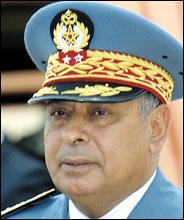Hamidou Laanigri
Hamidou Laanigri حميدو لعنيݣري | |
|---|---|
 | |
| General Inspector of the Auxiliary Forces | |
| Assumed office 2006 | |
| Director of the DST | |
| In office September 1999[1] – June 2003 | |
| Preceded by | Driss Basri |
| Succeeded by | [2] |
| Director of the DGSN Direction Générale de Sûreté Nationale | |
| In office July 2003[1] – September 2006 | |
| Preceded by | |
| Succeeded by | Charki Draiss |
| Personal details | |
| Born | 1939 (age 82–83) Meknes, Morocco |
| Military service | |
| Allegiance | |
| Branch/service | |
| Years of service | 1959–present |
| Rank | General |
| Commands | Commander-in-Chief of the Auxiliary Forces |
| Battles/wars | |
Hamidou Laanigri (Arabic: حميدو لعنيݣري) (born 1939 near Meknes)[1][3] is a Moroccan general and former head of the intelligence service of the Moroccan Ministry of the Interior. Laanigri was often accused of acts of torture in relation to the detention of Islamist activists after the 2003 Casablanca bombing and in connection with the secret Temara interrogation centre[3]
Early life[]
In 1956 Laanigri started his career in the military as a Corporal working with general Driss Benomar—who is also from Meknes. Benomar sent Laanigri first to the military training school of Ahermoumou and then to the Officers School of Dar al-Bayda (Officers academy of Meknes), graduating with the rank of Second lieutenant (sous-lieutenant).[1][3] He was deployed in Zag in 1960 and for a few months in Agadir. In 1962 he joined the Royal Moroccan Gendarmerie[1] a year later and was posted to Tangiers and then Kenitra.[3]
Gendarmerie career[]
In 1977 while a Colonel at the Gendarmerie he headed the military unit that was deployed to Zaire to help Mobutu quell a rebellion.[3] In 1979 he was sent to the United Arab Emirates as a security instructor, returning to Morocco only in 1989.[3]
Under Mohammed VI[]
In September 1999 he was promoted by Mohammed VI to head the DST (Direction de Surveillance du Territoire) as a replacement for Driss Basri. He was recommended by General Kadiri because he hated Islamists.[3]
In September 2006 he left the DST and was appointed as the General Inspector of the Auxiliary Forces. In late 2012 it was rumoured that he has retired,[4] however in January 2014 he was reported as being the head of this paramilitary unit.[5]
Laanigri was the instigator of the Groupes urbains de sécurité (nickname Croatia) which were disbanded after he left the police directorate.[6]
In September 2011, Laanigri survived a road accident.[7]
References[]
- ^ a b c d e Mahjoub Tobji (2006-09-13). Les officiers de Sa Majesté:Les dérives des généraux marocains 1956-2006. Fayard. ISBN 978-2-213-64072-3.
- ^ "Renouvellement à l'Intérieur: Hamidou Laânigri promu". L'Economiste. 28 July 2003. Retrieved 9 February 2014.
- ^ a b c d e f g Driss Bennani. "Exclusif. Portrait-enquête. Laânigri. Un destin marocain (Son ascension, sa chute…)". Telquel (N° 239). Archived from the original on 22 February 2014. Retrieved 5 February 2014.
- ^ "http://www.lemag.ma/Laanigri-et-10-autres-generaux-seraient-partis-a-la-retraite_a64751.html". lemag.ma. Retrieved 5 February 2014. External link in
|title=(help) - ^ "Maroc : Un colonel des Forces auxiliaires refuse de serrer la main de la première femme wali". Yabiladi. 4 February 2014. Retrieved 5 February 2014.
- ^ "Secrets d'État". Jeune Afrique. 25 September 2006. Retrieved 9 February 2014.
- ^ "Hamidou Laanigri victime d'un grave accident". Lakome.com. 5 September 2011. Retrieved 5 February 2014.
See also[]
- People from Meknes
- Moroccan generals
- Living people
- Moroccan expatriates in the United Arab Emirates
- Directors of intelligence agencies
- 1939 births
- People of Moroccan intelligence agencies